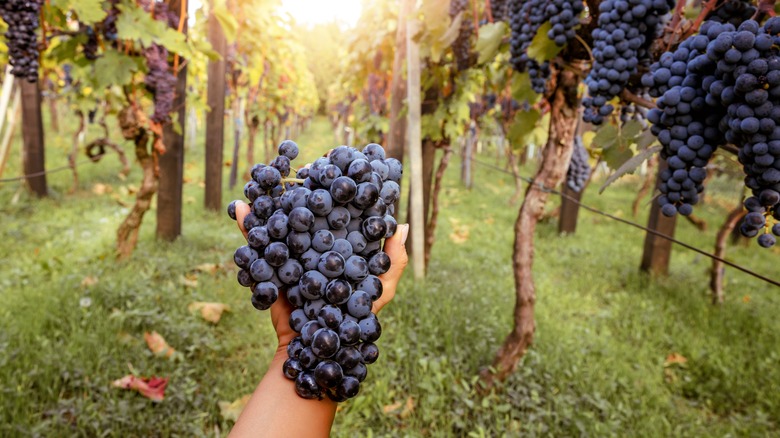Thanks To Climate Change, Your Favorite Wine Will Likely Never Taste The Same Again
Numerous factors determine the taste of your favorite wine, and the climate in which the grapes are grown is one of the biggest. Thanks to climate change — specifically rising temperatures in growing regions — you might soon find that your preferred bottle of red, white, rosé, or orange tastes different or doesn't exist anymore at all.
In an interview with Wine Enthusiast, Elizabeth M. Wolkovich, associate professor of Forest & Conservation Sciences at the University of British Columbia in Vancouver, Canada, explains the precarious balance between the beautifully complex taste of wine and the ease with which it can be irreversibly changed: "Wine grapes are extremely sensitive to climate and this is much of what makes wine so exquisite. But it also means wine grapes are extremely sensitive to climate change."
Temperature changes can affect the levels of sugar in wine grapes when harvested, which affects both the wine's character and its final alcohol content. Extreme changes in temperature can effectively kill the grapes, meaning they won't get harvested at all. In the longer term, climate change will affect which grape varieties can be grown where, not just changing the flavor of your favorite wine but its actual composition, too.
Why climate is so important in winemaking
An old adage in winemaking is that you can make bad wine from great grapes, but you can't make great wine from bad grapes. Getting great grapes starts with planting a variety suitable for the vineyard's climate, and harvesting them after they have ripened as fully as possible. When it involves higher temperatures, climate change rushes this process, and the anthocyanins and tannins that give a wine color and complexity won't fully develop. Excessive heat can also dry grapes out — while this is desirable when done intentionally, like in Italian Amarone wines, it mutes acidity and flavor development.
In extreme cases, climate change will push traditional varieties out of their best-known growing regions. More heat-resistant varieties like Shiraz and Tempranillo are already being trialed in Napa to get ahead of a time when Cabernet Sauvignon and Chardonnay can't thrive. In the future, grapes suited to extreme heat and lack of water, like the minerally, salty, and citrusy Assyrtiko that grows on the Greek island of Santorini, may be found in more parts of Europe and beyond. Conversely, rising temperatures are making regions previously unsuited to winemaking ripe for vineyards: The southeast of Britain is now a lauded wine producer, particularly for different types of sparkling wine.
It's not just warming that changes wine's flavor
Climate change doesn't just mean rising temperatures. Global warming is also causing more instances of extreme weather, including unexpected heavy rain, storms, hailstorms, and swings in temperature from hot to cold, and vice versa.
These have less of a direct flavor impact on grapes that are already growing; they are more likely to mean that the grapes are damaged, either by being waterlogged or overrun by fungus, mildew, or other mold that thrives in high-moisture conditions. But these can still change the flavor of a favorite wine in the same way as heat. A winemaker may be forced to plant new varieties that are more resistant to moisture or the problems it can bring about.
But too much water also literally waters down the grapes, reducing their juice content and concentration. If it's harvest season and a storm or heavy rain is on its way, winemakers will rush out to pick the grapes, even if it's early. This is because once watered down, there's no time to restore the sugar levels, and the grapes — and any wine made from them — will be ruined.


